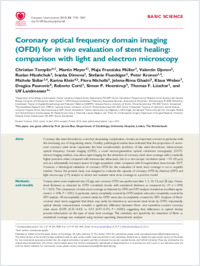Coronary optical frequency domain imaging (OFDI) for in vivo evaluation of stent healing: comparison with light and electron microscopy
- Templin, Christian Department of Cardiology, Cardiovascular Center, University Hospital Zurich, Switzerland
- Meyer, Martin Department of Cardiology, Cardiovascular Center, University Hospital Zurich, Switzerland
- Müller, Maja Franziska Department of Cardiology, Cardiovascular Center, University Hospital Zurich, Switzerland
- Djonov, Valentin Department of Medicine, Gross Anatomy and Vascular Biology, University of Fribourg, Switzerland
- Hlushchuk, Ruslan Department of Medicine, Gross Anatomy and Vascular Biology, University of Fribourg, Switzerland
- Dimova, Ivanka Department of Medicine, Gross Anatomy and Vascular Biology, University of Fribourg, Switzerland
- Flueckiger, Stefanie Department of Medicine, Gross Anatomy and Vascular Biology, University of Fribourg, Switzerland
- Kronen, Peter Veterinary Anaesthesia Services—International, Winterthur, Winterthur, Switzerland - Center of Applied Biotechnology and Molecular Medicine (CABMM), Vetsuisse Faculty, University of Zurich, Switzerland
- Sidler, Michele Veterinary Anaesthesia Services—International, Winterthur, Winterthur, Switzerland - Center of Applied Biotechnology and Molecular Medicine (CABMM), Vetsuisse Faculty, University of Zurich, Switzerland
- Klein, Karina Center of Applied Biotechnology and Molecular Medicine (CABMM), Vetsuisse Faculty, University of Zurich, Switzerland - Musculoskeletal Research Unit (MSRU), Vetsuisse Faculty, University of Zurich, Switzerland
- Nicholls, Flora Institute of Laboratory Animal Science, University Hospital Zurich, Switzerland
- Ghadri, Jelena-Rima Department of Cardiology, Cardiovascular Center, University Hospital Zurich, Switzerland
- Weber, Klaus Harlan Laboratories Itingen, Switzerland
- Paunovic, Dragica Terumo Europe N.V., European Medical and Clinical Division, Leuven, Belgium
- Corti, Roberto Department of Cardiology, Cardiovascular Center, University Hospital Zurich, Switzerland
- Hoerstrup, Simon P. Clinic for Cardiovascular Surgery, Department of Surgical Research, University Hospital Zurich, Switzerland
- Lüscher, Thomas F. Department of Cardiology, Cardiovascular Center, University Hospital Zurich, Switzerland
- Landmesser, Ulf Department of Cardiology, Cardiovascular Center, University Hospital Zurich, Switzerland
-
05.06.2010
Published in:
- European Heart Journal. - 2010, vol. 31, no. 14, p. 1792-1801
English
Aims Coronary late stent thrombosis, a rare but devastating complication, remains an important concern in particular with the increasing use of drug-eluting stents. Notably, pathological studies have indicated that the proportion of uncovered coronary stent struts represents the best morphometric predictor of late stent thrombosis. Intracoronary optical frequency domain imaging (OFDI), a novel second-generation optical coherence tomography (OCT)-derived imaging method, may allow rapid imaging for the detection of coronary stent strut coverage with a markedly higher precision when compared with intravascular ultrasound, due to a microscopic resolution (axial ∼10–20 µm), and at a substantially increased speed of image acquisition when compared with first-generation time-domain OCT. However, a histological validation of coronary OFDI for the evaluation of stent strut coverage in vivo is urgently needed. Hence, the present study was designed to evaluate the capacity of coronary OFDI by electron (SEM) and light microscopy (LM) analysis to detect and evaluate stent strut coverage in a porcine model.Methods and results Twenty stents were implanted into 10 pigs and coronary OFDI was performed after 1, 3, 10, 14, and 28 days. Neointimal thickness as detected by OFDI correlated closely with neointimal thickness as measured by LM (r = 0.90, P < 0.01). The comparison of stent strut coverage as detected by OFDI and SEM analysis revealed an excellent agreement (r = 0.96, P < 0.01). In particular, stents completely covered by OFDI analysis were also completely covered by SEM analysis. All incompletely covered stents by OFDI were also incompletely covered by SEM. Analyses of fibrin-covered stent struts suggested that these may rarely be detected as uncovered stent struts by OFDI. Importantly, optical density measurements revealed a significant difference between fibrin- and neointima-covered coronary stent struts [0.395 (0.35–0.43) vs. 0.53 (0.47–0.57); P < 0.001], suggesting that differences in optical density provide information on the type of stent strut coverage. The sensitivity and specificity for detection of fibrin vs. neointimal coverage was evaluated using receiver-operating characteristic analysis.Conclusion The present study demonstrates that OFDI is a highly promising tool for accurate evaluation of coronary stent strut coverage, as supported by a high agreement between OFDI and light and electron microscopic analysis. Furthermore, our data indicate that optical density measurements can provide additional information with respect to the type of stent strut coverage, i.e. fibrin vs. neointimal coverage. Therefore, coronary OFDI analysis will provide important information on the biocompatibility of coronary stents.
- Faculty
- Faculté des sciences et de médecine
- Department
- Département de Médecine
- Language
-
- English
- Classification
- Biological sciences
- License
-
License undefined
- Identifiers
-
- RERO DOC 20377
- DOI 10.1093/eurheartj/ehq168
- Persistent URL
- https://folia.unifr.ch/unifr/documents/301745
Statistics
Document views: 119
File downloads:
- Document: 176
